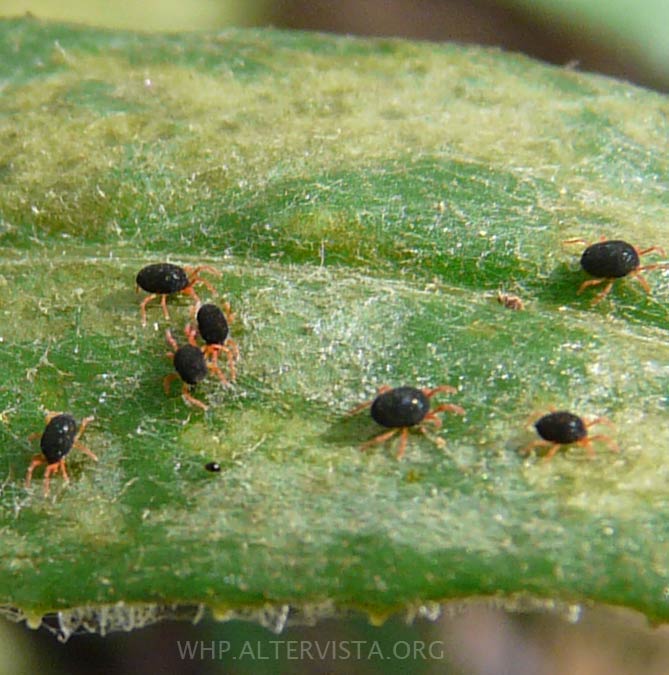
The Red-legged Earth Mite Halotydeus destructor is believed to have reached Australia in hay imported from South Africa during a drought in 1914, although it may not be native to Africa. It is now common in all parts of Australia with a Mediterranean climate. The mites feed by sucking out the contents of individual leaf cells. They feed in groups on the upper side of leaves, but spend most of the time sheltering on the ground where it is more humid. Many broad-leafed herbaceous plants are attacked, both native and weedy. The following lists are preliminary.
Native plants attacked by Red-legged Earth Mites at Woodlands
- Scaly Buttons
- Spur Velleia
- Narrow Plantain
- Cotton Fireweed (some plants only)
- Chocolate Lily (some plants only)
- Kidney Weed (very rarely)
- Common Everlasting
The first three appear to be seriously impacted, and the mites may be a major reason why these species are rare in the park. In other locations mites have been seen to affect many other native plants, including peas, orchids and especially the smaller daisies (Robinson 2007), but many of the susceptible species are already extinct at Woodlands. One small daisy species which appears to be immune is Solenogyne which is very common at the north end of the former Greenvale Sanatorium Land.
Weeds attacked by Red-legged Earth Mites at Woodlands
- Ribwort (often)
- Cats Ear (some plants only)
- Spear Thistle
- Black Nightshade
The Mites are a major pest of crops such as Canola and of the clover component of pastures, and are normally controlled by pesticides. Research into the pest and its control has been summarized by Ridsdill-Smith and others (2008). I have not found any published research on management of the mites in natural areas. However there are a number of native mites and spiders which prey on the Red-legged Earth Mite, as well as one mite which was introduced (ignorantly) from Europe for the purpose. Tsitsilas and others (2006) found that in shelter-belts (strips of native trees) planted on farms predators were more common and Red-legged Earth Mites were rare, and that this effect extended up to 50m into adjacent pasture. The effect was much greater when the shelterbelts also contained native shrubs and long grass. Due to other research cited, the significant factor was thought to be the length of the grass, which did not necessarily have to be native.
Small herbaceous plants cannot grow in long grass, so this research suggests the desirability of having a mosaic of short and long grass. Due to the constant Kangaroo grazing pressure at Woodlands, long grass in dry years only exists under fallen branches or where Kangaroos are excluded by fencing.
Red-legged Earth Mites die off in summer and their eggs hatch in Autumn. Although more research is needed, fire may destroy most of the eggs and give herbaceous plants a chance to multiply before the mites re-invade. The parts of the park where susceptible species are threatened have been burnt either once or not at all since the formation of the park. Unfortunately any fire is likely to be patchy due to the dense growth of saplings in these areas, and may well affect the predators more than the pest.